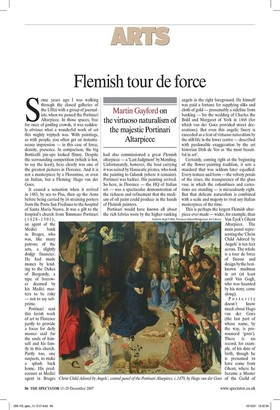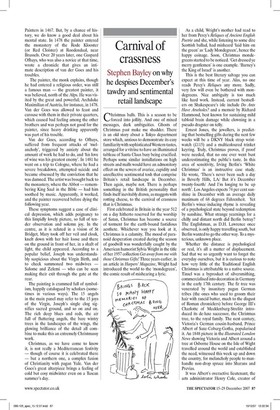Flemish tour de force
Martin Gaylord on the virtuoso naturalism of the majestic Portinari Altarpiece Some years ago I was walking through the closed galleries of the Uffizi with a group of journalists, when we passed the Portinari Altarpiece. In those spaces, free for once of jostling crowds, it was suddenly obvious what a wonderful work of art this mighty triptych was. With paintings, as with people, you often get an instantaneous impression — in this case of force, density, presence. In comparison, the big Botticelli pin-ups looked flimsy. Despite the surrounding competition (which is hot, to say the least), here clearly was one of the greatest pictures in Florence. And it is not a masterpiece by a Florentine, or even an Italian, but a Fleming: Hugo van der Goes.
It caused a sensation when it arrived in 1483, by sea to Pisa, then up the Arno before being carried by 16 straining porters from the Porta San Frediano to the hospital of Santa Maria Nuova. It was a gift to the hospital's church from Tommaso Portinari ( 1 4 2 8 - 1 5 1 ) , an agent of the Medici bank in Bruges, who was, like many patrons of the arts, a slightly dodgy financier. He had made money by lending to the Dukes of Burgundy, a type of borrower deemed by his Medici masters to be risky — not to say subprime.
Portinari sent this lavish work of art to Florence partly to provide a focus for daily masses said for the souls of himself and his family in this church. Partly too, one suspects, to make a splash back home. His predecessor as Medici agent in Bruges had also commissioned a great Flemish altarpiece — a 'Last Judgment' by Memling. Unfortunately, however, the boat carrying it was seized by Hanseatic pirates, who took the painting to Gdansk (where it remains). Portinari was luckier. His painting arrived. So here, in Florence — the HQ of Italian art — was a spectacular demonstration of the richness and refinement that the medium of oil paint could produce in the hands of Flemish painters.
Portinari would have known all about the rich fabrics worn by the higher-ranking angels in the right foreground. He himself was paid a fortune for supplying silks and cloth of gold — presumably a sideline from banking — for the wedding of Charles the Bold and Margaret of York in 1468 (for which van der Goes provided street decorations). But even this angelic finery is exceeded as a feat of virtuoso naturalism by the still life in the lower centre — described with pardonable exaggeration by the art historian Dirk de Vos as 'the most beautiful in art'.
Certainly, coming right at the beginning of the flower-painting tradition, it sets a standard that was seldom later equalled. Every texture and form — the velvety petals of the irises, the transparency of the glass vase in which the columbines and carnations are standing — is miraculously right. But that delicate naturalism is combined with a scale and majesty to rival any Italian masterpiece of the time.
This is perhaps the largest Flemish altarpiece ever made —wider, for example, than Van Eyck's Ghent Altarpiece. The main panel representing the 'Christ Child Adored by Angels' is ten feet across. The whole is a tour de force of finesse and design by the bestknown madman in art (at least until Van Gogh, who was haunted by his story, came along).
Posterity doesn't know much about Hugo van der Goes (the last part of whose name, by the way, is pronounced `goos'). There is no record, for example, of his date of birth, though he is presumed to have come from Ghent, where he became a Master of the Guild of renee/Alinari/Bridgeman Art Library Painters in 1467. But, by a chance of history, we do know a good deal about his mental state. In 1478 the painter entered the monastery of the Rode Klooster (or Red Cloister) at Roodendaal, near Brussels. Over 20 years later, one Gaspard Ofhuys, who was also a novice at that time, wrote a chronicle that gives an intimate description of van der Goes and his troubles.
The painter, the monk explains, though he had entered a religious order, was still a famous man — the greatest painter, it was believed, north of the Alps. He was visited by the great and powerful; Archduke Maximilian of Austria, for instance, in 1478. Van der Goes was allowed to feast and carouse with them in their private quarters, which caused bad feeling among the other brothers and was perhaps not good for the painter, since heavy drinking apparently was part of his trouble.
Van der Goes, according to Ofhuys, suffered from frequent attacks of 'melancholy', triggered by anxiety about the amount of work he had to do, and 'his love of wine was his greatest enemy'. In 1481 he went on a trip to Cologne, where he had a severe breakdown, attempted suicide and became obsessed by the conviction that he was damned. The artist was brought back to the monastery, where the Abbot — remembering King Saul in the Bible — had him soothed by music. Apparently, it worked, and the painter recovered before dying the following year.
These symptoms suggest a case of clinical depression, which adds poignancy to this limpidly lovely picture, so full of tender observation and solemn joy. In the centre, as it is related in a vision of St Bridget, Mary took off her veil and cloak, knelt down with her hair loose and there on the ground in front of her, in a shaft of light, the child appeared. According to a popular belief, Joseph was understandably suspicious about the Virgin Birth, and to check summoned two midwives — Salome and Zelemi — who can be seen making their exit through the gate at the rear.
The painting is crammed full of symbolism, happily catalogued by scholars (sometimes in various ways). The 15 angels in the main panel may refer to the 15 joys of the Virgin, Joseph's single clog signifies sacred ground, and so on and on. The rich deep blues and reds, the air full of fluttering angels, the bare wintry trees in the landscapes of the wings, the glowing brilliance of the detail all combine to make this an extremely Christmassy work.
Christmas, as we have come to know it, is not really a Mediterranean festivity — though of course it is celebrated there — but a northern one, a complex fusion of Christianity with pagan Yule. Van der Goes's great altarpiece brings a feeling of cold but cosy midwinter even on a Tuscan summer's day.


































































































 Previous page
Previous page